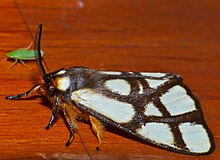
Gracillariidae is an important family of insects in the order Lepidoptera and the principal family of leaf miners that includes several economic, horticultural or recently invasive pest species such as the horse-chestnut leaf miner, Cameraria ohridella.
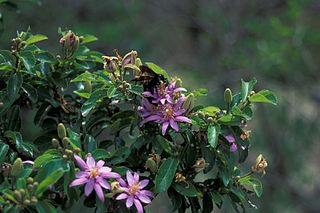
Grewia is a large flowering plant genus in the mallow family Malvaceae, in the expanded sense as proposed by the Angiosperm Phylogeny Group. Formerly, Grewia was placed in either the family Tiliaceae or the Sparrmanniaceae. However, these were both not monophyletic with respect to other Malvales - as already indicated by the uncertainties surrounding placement of Grewia and similar genera - and have thus been merged into the Malvaceae. Together with the bulk of the former Sparrmanniaceae, Grewia is in the subfamily Grewioideae and therein the tribe Grewieae, of which it is the type genus.

Pterolonchidae is a small family of very small moths in the superfamily Gelechioidea. There are species native to every continent except Australia and Antarctica.

Dombeya rotundifolia, the dikbas or "South African wild pear", is a small deciduous tree with dark grey to blackish deeply fissured bark, found in Southern Africa and northwards to central and eastern tropical Africa. Formerly placed in the Sterculiaceae, that artificial group has now been abandoned by most authors and the plants are part of an enlarged Malvaceae.

Anaphe is a genus of moths in the family Notodontidae erected by Francis Walker in 1855.
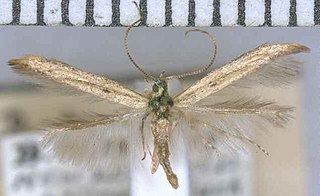
Batrachedra arenosella, the armoured scale eating caterpillar or the coconut moth, is a species of moth of the family Batrachedridae. It was first described by Francis Walker using specimens collected in Auckland, New Zealand. It has been hypothesised that the New Zealand moth may contain two distinct species. As well as the moth species in New Zealand, this name has been applied, perhaps incorrectly, to moths found in India, Indonesia, the Malay Peninsula, and Réunion, as well as in Australia, from the Northern Territory and northern Queensland to New South Wales and South Australia.
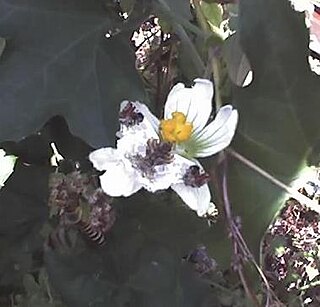
Netrobalane canopus, the buff-tipped skipper, is a butterfly of the family Hesperiidae. It is found in savannah in Africa, from South Africa to Kenya to Nigeria and southern Sudan.
Abantis pillaana, the ragged skipper, is a butterfly of the family Hesperiidae. It is found in South Africa, Zimbabwe, Botswana, from Mozambique to eastern Africa, Ethiopia and south-western Arabia.

Lophostethus dumolinii is a moth of the family Sphingidae. It is known from most habitats, except desert and high mountains throughout the Ethiopian Region, excluding Madagascar and the Cape in South Africa.

Achyra massalis, the ombava, is a moth of the family Crambidae. The species was described by Francis Walker in 1859. It is found in most of the Old World tropics, including Réunion, Namibia and Australia.

Glyphodes negatalis, the karanj defoliator, is a moth of the family Crambidae. The species was first described by Francis Walker in 1859. It has a wide range in the tropics, including South Africa, The Gambia, Mali, India, Sri Lanka, Hong Kong, Japan, and eastern Australia.

Pappea capensis is a South African tree in the family Sapindaceae. It is the only species in the genus Pappea.

Bradina admixtalis is a species of moth of the family Crambidae described by Francis Walker in 1859. It is found in Australia, New Guinea, New Zealand, south-east Asia and the Comoros, Réunion, South Africa as well as India.
Metoecis is a monotypic snout moth genus described by Paul Mabille in 1879. Its only species, Metoecis carnifex, was described by Charles Coquerel in 1855. It is found on Madagascar and South Africa.

Hymenoptychis sordida, the pneumatophore moth, is a moth of the family Crambidae. The species was first described by Philipp Christoph Zeller in 1852. It is known from Australia, southern and South-East Asia, several Pacific islands, Seychelles, South Africa, Madagascar and the United Arab Emirates.
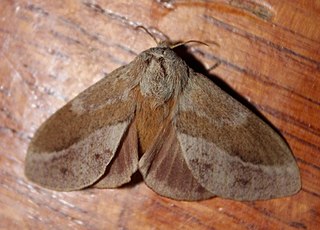
Eutricha capensis, the Cape lappet moth, is a species of moth in the family Lasiocampidae primarily found in South Africa. During the larval stage, Cape lappets feed on a wide variety of African plants and can often be found aggregating in gardens. The caterpillars are brightly coloured and conspicuously hairy, while the bulky adult moths are mostly brown and much less striking in appearance.
Anaphe panda is a moth of the family Notodontidae. It was described by Jean Baptiste Boisduval in 1847. It is found in Cameroon, the Democratic Republic of the Congo, Equatorial Guinea, Kenya, Malawi, South Africa, Tanzania and the Gambia.
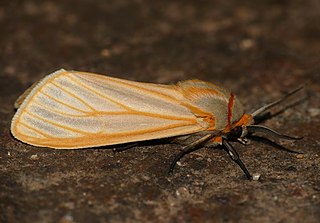
Afromurzinia lutescens is a moth in the family Erebidae. It was described by Francis Walker in 1855. It is found in Angola, Cameroon, the Democratic Republic of the Congo, Equatorial Guinea, Ethiopia, Ghana, Guinea, Guinea-Bissau, Kenya, Nigeria, Sierra Leone, Somalia, South Africa, Tanzania, Togo, Uganda and Zimbabwe.

Grewia bicolor, called bastard brandy bush, false brandy bush, two-coloured grewia, white-leaved grewia, white-leaved raisin, white raisin and donkey berry, is a species of flowering plant in the family Malvaceae, native to sub-Saharan Africa, Yemen, Oman, and the Indian subcontinent. In Africa Grewia bicolor is one of the most important forages during the dry season, when all herbivores, wild and domestic, find it palatable. It is particularly enjoyed by giant eland and domestic goats. Caterpillars of Anaphe reticulata have been found to feed on the foliage.

Grewia flavescens, called rough-leaved raisin, sandpaper raisin, and donkey berry, is a species of flowering plant in the family Malvaceae, native to sub‑Saharan Africa, Yemen, Saudi Arabia, and India. It is considered to be an underutilized crop, both for its fruit and its use for livestock forage. Caterpillars of Anaphe reticulata have been found to feed on the foliage.
